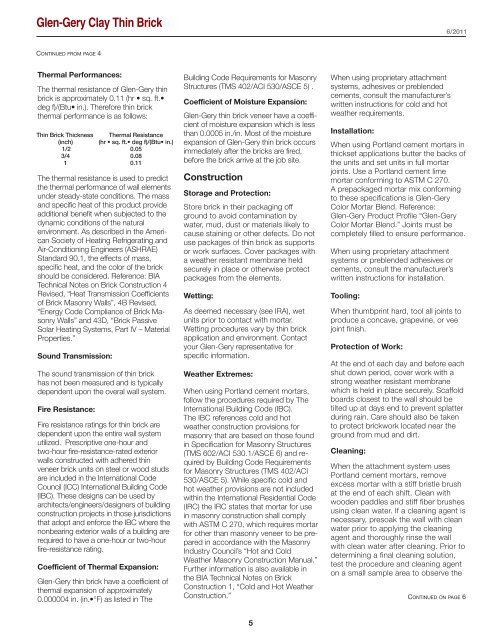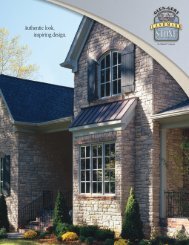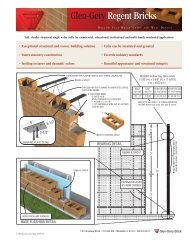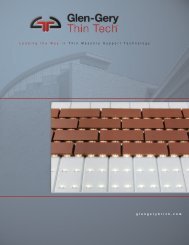Glen-Gery Clay Thin Brick
Glen-Gery Clay Thin Brick
Glen-Gery Clay Thin Brick
You also want an ePaper? Increase the reach of your titles
YUMPU automatically turns print PDFs into web optimized ePapers that Google loves.
<strong>Glen</strong>-<strong>Gery</strong> <strong>Clay</strong> <strong>Thin</strong> <strong>Brick</strong><br />
CONTINUED FROM PAGE 4<br />
Thermal Performances:<br />
The thermal resistance of <strong>Glen</strong>-<strong>Gery</strong> thin<br />
brick is approximately 0.11 (hr • sq. ft.•<br />
deg f)/(Btu• in.). Therefore thin brick<br />
thermal performance is as follows:<br />
<strong>Thin</strong> <strong>Brick</strong> Thickness Thermal Resistance<br />
(inch) (hr • sq. ft.• deg f)/(Btu• in.)<br />
1/2 0.05<br />
3/4 0.08<br />
1 0.11<br />
The thermal resistance is used to predict<br />
the thermal performance of wall elements<br />
under steady-state conditions. The mass<br />
and specific heat of this product provide<br />
additional benefit when subjected to the<br />
dynamic conditions of the natural<br />
environment. As described in the American<br />
Society of Heating Refrigerating and<br />
Air-Conditioning Engineers (ASHRAE)<br />
Standard 90.1, the effects of mass,<br />
specific heat, and the color of the brick<br />
should be considered. Reference: BIA<br />
Technical Notes on <strong>Brick</strong> Construction 4<br />
Revised, “Heat Transmission Coefficients<br />
of <strong>Brick</strong> Masonry Walls”, 4B Revised,<br />
“Energy Code Compliance of <strong>Brick</strong> Masonry<br />
Walls” and 43D, “<strong>Brick</strong> Passive<br />
Solar Heating Systems, Part IV – Material<br />
Properties.”<br />
Sound Transmission:<br />
The sound transmission of thin brick<br />
has not been measured and is typically<br />
dependent upon the overal wall system.<br />
Fire Resistance:<br />
Fire resistance ratings for thin brick are<br />
dependent upon the entire wall system<br />
utilized. Prescriptive one-hour and<br />
two-hour fire-resistance-rated exterior<br />
walls constructed with adhered thin<br />
veneer brick units on steel or wood studs<br />
are included in the International Code<br />
Council (ICC) International Building Code<br />
(IBC). These designs can be used by<br />
architects/engineers/designers of building<br />
construction projects in those jurisdictions<br />
that adopt and enforce the IBC where the<br />
nonbearing exterior walls of a building are<br />
required to have a one-hour or two-hour<br />
fire-resistance rating.<br />
Coefficient of Thermal Expansion:<br />
<strong>Glen</strong>-<strong>Gery</strong> thin brick have a coefficient of<br />
thermal expansion of approximately<br />
0.000004 in. (in.•°F) as listed in The<br />
Building Code Requirements for Masonry<br />
Structures (TMS 402/ACI 530/ASCE 5) .<br />
Coefficient of Moisture Expansion:<br />
<strong>Glen</strong>-<strong>Gery</strong> thin brick veneer have a coefficient<br />
of moisture expansion which is less<br />
than 0.0005 in./in. Most of the moisture<br />
expansion of <strong>Glen</strong>-<strong>Gery</strong> thin brick occurs<br />
immediately after the bricks are fired,<br />
before the brick arrive at the job site.<br />
Construction<br />
Storage and Protection:<br />
Store brick in their packaging off<br />
ground to avoid contamination by<br />
water, mud, dust or materials likely to<br />
cause staining or other defects. Do not<br />
use packages of thin brick as supports<br />
or work surfaces. Cover packages with<br />
a weather resistant membrane held<br />
securely in place or otherwise protect<br />
packages from the elements.<br />
Wetting:<br />
As deemed necessary (see IRA), wet<br />
units prior to contact with mortar.<br />
Wetting procedures vary by thin brick<br />
application and environment. Contact<br />
your <strong>Glen</strong>-<strong>Gery</strong> representative for<br />
specific information.<br />
Weather Extremes:<br />
When using Portland cement mortars,<br />
follow the procedures required by The<br />
International Building Code (IBC).<br />
The IBC references cold and hot<br />
weather construction provisions for<br />
masonry that are based on those found<br />
in Specification for Masonry Structures<br />
(TMS 602/ACI 530.1/ASCE 6) and required<br />
by Building Code Requirements<br />
for Masonry Structures (TMS 402/ACI<br />
530/ASCE 5). While specific cold and<br />
hot weather provisions are not included<br />
within the International Residential Code<br />
(IRC) the IRC states that mortar for use<br />
in masonry construction shall comply<br />
with ASTM C 270, which requires mortar<br />
for other than masonry veneer to be prepared<br />
in accordance with the Masonry<br />
Industry Council’s “Hot and Cold<br />
Weather Masonry Construction Manual.”<br />
Further information is also available in<br />
the BIA Technical Notes on <strong>Brick</strong><br />
Construction 1, “Cold and Hot Weather<br />
Construction.”<br />
5<br />
When using proprietary attachment<br />
systems, adhesives or preblended<br />
cements, consult the manufacturer’s<br />
written instructions for cold and hot<br />
weather requirements.<br />
6/2011<br />
Installation:<br />
When using Portland cement mortars in<br />
thickset applications butter the backs of<br />
the units and set units in full mortar<br />
joints. Use a Portland cement lime<br />
mortar conforming to ASTM C 270.<br />
A prepackaged mortar mix conforming<br />
to these specifications is <strong>Glen</strong>-<strong>Gery</strong><br />
Color Mortar Blend. Reference:<br />
<strong>Glen</strong>-<strong>Gery</strong> Product Profile “<strong>Glen</strong>-<strong>Gery</strong><br />
Color Mortar Blend.” Joints must be<br />
completely filled to ensure performance.<br />
When using proprietary attachment<br />
systems or preblended adhesives or<br />
cements, consult the manufacturer’s<br />
written instructions for installation.<br />
Tooling:<br />
When thumbprint hard, tool all joints to<br />
produce a concave, grapevine, or vee<br />
joint finish.<br />
Protection of Work:<br />
At the end of each day and before each<br />
shut down period, cover work with a<br />
strong weather resistant membrane<br />
which is held in place securely. Scaffold<br />
boards closest to the wall should be<br />
tilted up at days end to prevent splatter<br />
during rain. Care should also be taken<br />
to protect brickwork located near the<br />
ground from mud and dirt.<br />
Cleaning:<br />
When the attachment system uses<br />
Portland cement mortars, remove<br />
excess mortar with a stiff bristle brush<br />
at the end of each shift. Clean with<br />
wooden paddles and stiff fiber brushes<br />
using clean water. If a cleaning agent is<br />
necessary, presoak the wall with clean<br />
water prior to applying the cleaning<br />
agent and thoroughly rinse the wall<br />
with clean water after cleaning. Prior to<br />
determining a final cleaning solution,<br />
test the procedure and cleaning agent<br />
on a small sample area to observe the<br />
CONTINUED ON PAGE 6








